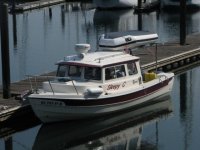Hi Gene & Mary,
I hope I can explain this so it makes sense.
Getting it up and down is pretty easy when on the water. I do this by myself. The inflatable is a Wolverene, the exact copy of the popular Alaskan, by the same manufacture, just from a different plant. I don’t remember the exact weight but around 55# is close.
I bring the dingy up to the stbd side and lift the bow end up and rest it on the gunnel. Usually let it rest there a while to dry some. Then bring it up and forward toward the CD center line tilting it on it’s side with the bow down into the cockpit so it is standing on its bow end. This is more of a rolling over the gunnel than a lifting movement. The aft end of the dingy then leans back toward the rack. Then, lifting the bow end and letting the aft end rock over the rack like teeter-totter, I slide the bow end forward, lifting it up onto the aft cabin roof. There is no rack on the cabin top, I just use a towel for protection of the gel coat. The dingy is secured with its bowline through the handrails on the cabin top forward and a line aft to the rack.
Deploying to the water is basically the reverse. I tried just dropping it from the rack, over the side once but I got splashed pretty good. Probably be OK on a nice hot day though.
The frame and rack is all stainless steel, 304 I believe. Doing it again I would insist on 316, but moving on. It is in 5 pieces. Two, the bases are permanently attached to the boat at the lazzarette, using the horizontal surfaces for weight support, the verticals for the anti-racking, and the diagonals for stability and all welded together to make the fab guy go crazy. It is through bolted on all angles. The vertical sections are where the “pipe base” is welded onto the plates and where the removable uprights set into. The removable sections are 2 vertical pipes, and one horizontal with two “tees” that fit down onto the tops of the verticals. They are all stainless pipe, not tubing, and when assembled there is very little racking. When apart, the 3 pieces will lay in the galley hallway, if needed, for transport or storage.
The rack height was set so that I would be able to see out to aft with the inflatable up there. That works. The curve of the bow on the inflatable, raises the forward just a bit and is higher on the cabin roof, so there is very little obstruction to getting on and off the CD with the inflatable in place. I carry it in the inverted position, so as not to fill with water should it rain. It is not quite wide enough to keep rain out of the cockpit but it does afford a place to stand that is dry and keep rain out of the door if it is raining. I have used a tarp over the inflatable to enclose the cockpit somewhat. It is not as enclosed as a full camper-back canvas, but then that is not what I was after anyway.
It has worked for me. It was probably overbuilt, by my choice, so has added some stern weight, but is dual purpose and effective. I’ll probably keep it.
Hope that helps.
Harvey
SleepyC :moon


